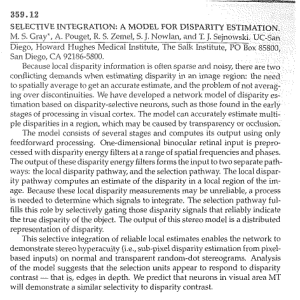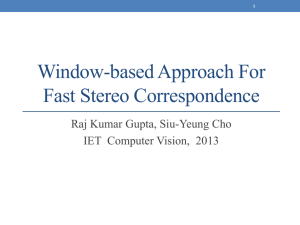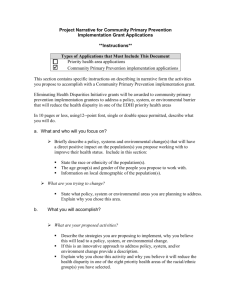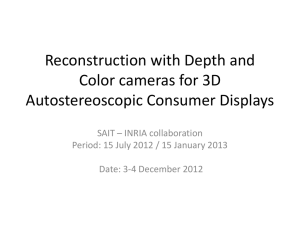Technical Report 2003-02-CIRL-CS-JHU Stereo-Based Direct Surface Tracking with Deformable Parametric Models
advertisement
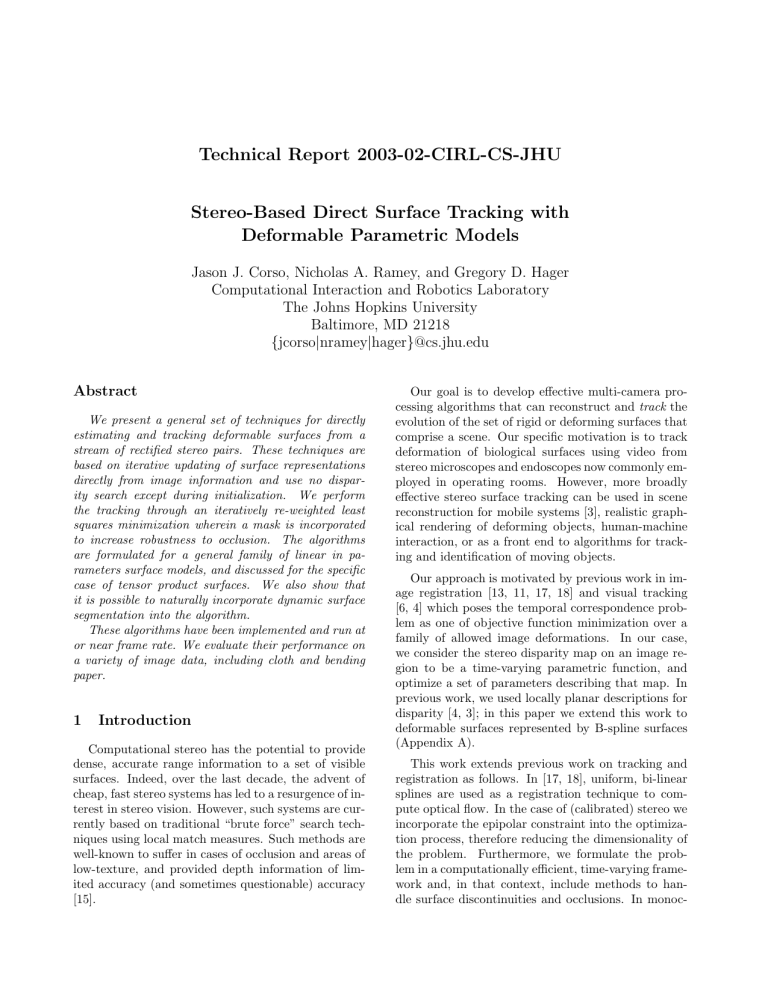
Technical Report 2003-02-CIRL-CS-JHU
Stereo-Based Direct Surface Tracking with
Deformable Parametric Models
Jason J. Corso, Nicholas A. Ramey, and Gregory D. Hager
Computational Interaction and Robotics Laboratory
The Johns Hopkins University
Baltimore, MD 21218
{jcorso|nramey|hager}@cs.jhu.edu
Abstract
We present a general set of techniques for directly
estimating and tracking deformable surfaces from a
stream of rectified stereo pairs. These techniques are
based on iterative updating of surface representations
directly from image information and use no disparity search except during initialization. We perform
the tracking through an iteratively re-weighted least
squares minimization wherein a mask is incorporated
to increase robustness to occlusion. The algorithms
are formulated for a general family of linear in parameters surface models, and discussed for the specific
case of tensor product surfaces. We also show that
it is possible to naturally incorporate dynamic surface
segmentation into the algorithm.
These algorithms have been implemented and run at
or near frame rate. We evaluate their performance on
a variety of image data, including cloth and bending
paper.
1
Introduction
Computational stereo has the potential to provide
dense, accurate range information to a set of visible
surfaces. Indeed, over the last decade, the advent of
cheap, fast stereo systems has led to a resurgence of interest in stereo vision. However, such systems are currently based on traditional “brute force” search techniques using local match measures. Such methods are
well-known to suffer in cases of occlusion and areas of
low-texture, and provided depth information of limited accuracy (and sometimes questionable) accuracy
[15].
Our goal is to develop effective multi-camera processing algorithms that can reconstruct and track the
evolution of the set of rigid or deforming surfaces that
comprise a scene. Our specific motivation is to track
deformation of biological surfaces using video from
stereo microscopes and endoscopes now commonly employed in operating rooms. However, more broadly
effective stereo surface tracking can be used in scene
reconstruction for mobile systems [3], realistic graphical rendering of deforming objects, human-machine
interaction, or as a front end to algorithms for tracking and identification of moving objects.
Our approach is motivated by previous work in image registration [13, 11, 17, 18] and visual tracking
[6, 4] which poses the temporal correspondence problem as one of objective function minimization over a
family of allowed image deformations. In our case,
we consider the stereo disparity map on an image region to be a time-varying parametric function, and
optimize a set of parameters describing that map. In
previous work, we used locally planar descriptions for
disparity [4, 3]; in this paper we extend this work to
deformable surfaces represented by B-spline surfaces
(Appendix A).
This work extends previous work on tracking and
registration as follows. In [17, 18], uniform, bi-linear
splines are used as a registration technique to compute optical flow. In the case of (calibrated) stereo we
incorporate the epipolar constraint into the optimization process, therefore reducing the dimensionality of
the problem. Furthermore, we formulate the problem in a computationally efficient, time-varying framework and, in that context, include methods to handle surface discontinuities and occlusions. In monoc-
ular tracking, one of the principle difficulties is the
lack of 3D information. Indeed, almost all monocular tracking methods make some implicit or explicit
assumption about the 3D structure of the tracked object [12, 7] and compute interframe or sequence motion based on it. In our case, we are directly inferring
the 3D structure of the surface and do not explicitly
track the motion of points on the surface [9, 16]. Finally, since we do not track motion, our algorithms
can benefit from projected scene texture to improve
local surface discriminability and accuracy [10]. In
fact, we can even tailor the light to best improve the
performance of local optimization.
The remainder of this paper is structured as follows.
In the next section, we formulate the optimization
problem and present a solution for parameter updates
and mask computation. In Section 3, we describe two
implementations of our algorithm and present results
demonstrating its performance. In Section 4, we discuss some extensions of our algorithms and in 5 we
conclude.
2
Mathematical Formulation
In this development, we assume a calibrated stereo
system. Thus, incoming pairs of images can be rectified to form an equivalent non-verged stereo pair. Let
L(u, v, t) and R(u, v, t) denote the left and right rectified image pair at time t, respectively.
In the non-verged case, the disparity map, D is a
mapping from image coordinates to a scalar offset such
that L(u, v, t) and R(u + D(u, v), v, t) are the projection of the same physical point in 3D space. As outlined above, our objective is to estimate a set of parameters p ∈ <n that describe a parametric disparity
map D : <n × <2 → <1 . This disparity map is defined on a given region A of pixel locations in the left
image. For simplicity, we will consider A to be an enumeration of image locations and write A = {(ui , vi )0 },
1 ≤ i ≤ N.
In traditional region-based stereo, correspondences
are computed by a search process that locates the
maximum of a similarity measure defined on image
regions. As we intend to perform a continuous optimization over p, we are interested in analytical similarity measures. In this realm, candidate functions
include sum of squared differences (SSD), zero-mean
SSD (ZSSD), and normalized cross-correlation (NCC)
to name a few. Robust objective functions [8] might
also be considered. As we show below, we achieve similar effects using a reweighting loop in the optimization
[5].
We choose our objective to be ZSSD. In practice,
zero-mean comparison measures greatly outperform
their non-zero-mean counterparts [1] as they provide a
measure of invariance over local brightness variations.
If the average is computed using Gaussian weighting,
then this difference can be viewed as an approximation to convolving with the Laplacian of a Gaussian.
Indeed, such a convolution is often employed with the
same goal of achieving local illumination invariance.
Let L(u, v, t) = L(u, v, t) − (L ∗ M )(u, v, t) and
R(u, v, t) = R(u, v, t) − (R ∗ M )(u, v, t) where ∗ denotes convolution and M is an appropriate averaging
filter kernel in the spatial-temporal domain. We can
then write our chosen optimization criterion as
X
wi (L(ui , vi , t) − R(ui + D(p; ui , vi ), vi , t))2
O(p) =
(ui ,vi )
(1)
where wi is an optional weighting factor for location
(ui , vi )0 .
For compactness of notation, consider A to be
fixed and write L(t) to denote the N × 1 column
vector
(L(u1 , v1 , t), L(u2 , v2 , t), . . . L(uN , vN , t))0 .
Likewise, we define R(p, t)
=
(R(u1 +
D(p; u1 , v1 ), v1 , t), . . . R(uN + D(p; uN , vN ), vN , t))0 .
Finally, for convenience we will also write
D(p) = (D(p; u1 , v1 ) . . . D(p, uN , vN ))0 .
We now adopt the same method as in [13, 11, 6]
and expand R(p, t) in a Taylor series about a nominal
value of p. In this case, we have
O(4p)
= k(L(t) − R(p + 4p, t))W 1/2 k2
≈ k(L(t) − R(p, t) − J(p, t)4p)W 1/2 k2
= k(E(p, t) − J(p, t)4p)W 1/2 k2
(2)
where E(p, t) ≡ L(t)−R(p, t), J(p, t) = ∂R/∂p is the
N × n Jacobian matrix of R considered as a function
of p, and W = diag(w1 , w2 , . . . wN ). Furthermore, if
we define JD (p) = ∂D/∂p, we have
J(p, t) = diag(Lx (t))JD (p)
(3)
where Lx (t) is the vector of spatial derivatives of L(t)
taken along the rows 1
It immediately follows that the optimal 4p is the
solution to the (overdetermined) linear system
1 Here, we should in fact use the spatial derivatives of the
right image after warping or a linear combination of left and
right image derivates. However in practice using just left image
derivatives works well and avoids the need to recompute image
derivatives if iterative warping is used.
J(p, t)t W J(p, t) 4p = J(p, t)t W E(p, t)
(4)
In the case that the disparity function is linear in
parameters, JD is a constant matrix and J varies only
due to time variation of the gradients on the image
surface.
At this point, the complete surface tracking algorithm can now be written as follows:
basis functions, and define Bi,k = Nk,p (αi ) ∗ Nk,q (βi )
for all (αi , βi ) ∈ A. It immediately follows that we can
create the N × mn matrix B
B1,1 , B1,2 ....B1,mn
B2,1 , B2,2 ....B2,mn
B≡
..
.
BN,1 , BN,2 ....BN,mn
and write
1. Acquire a pair of stereo images and rectify them.
2. Convolve both images with an averaging filter and
subtract the result.
3. Compute spatial x derivatives in the zero-mean
left image.
4. Warp the right image by a nominal disparity map
(e.g. that computed in the previous step and subtract from the zero mean left image.
5. Solve (4).
The final two steps may be iterated if desired to
achieve higher precision. The entire procedure may
also be repeated at multiple scales to improve convergence, if desired. In practice we have not found this
to be necessary.
2.1
Surface Formulations
In practice, we have found this formulation most
effective for tracking disparity functions that are linear in their parameters (thus avoiding the problem of
recomputing the Jacobian of the disparity function at
runtime). A example is when the viewed surface is
planar [3]. In this case, it is not hard to show that
disparity is an affine function of image location, that
is:
D(a, b, c; u, v) = au + bv + c
(5)
A more general example of a linear in parameters
model is a B-spline. Consider a set of scanline locations α and row locations β, such that (α, β) ∈ A.
With m parameters per scanline and n parameters for
row locations, a pth by qth degree tensor B-spline is a
disparity function of the form
D(p; α, β) =
m X
n
X
Nı,p (α) Nj,q (β) pi,j
(6)
i=0 j=0
To place this in the framework above, let κ denote
an indexing linear enumeration of the mn evaluated
D(p) = Bp
(7)
It follows that the formulation of the previous section applies directly with JD = B.
2.2
Reweighting
One of the potential limitations with the system
thus far is that is assumes that all pixels in the region
of interest fall on a continuous surface. In particular,
an occluding surface introduces a C 0 discontinuity into
the problem. As we discuss in Section 4, it is possible
to directly introduce C 0 discontinuities into the spline
formulation. However, for now we consider such “outliers” to be undesirable and to be avoided.
There are any number of methods for incorporating some type of robustness into an otherwise
smooth L2 style optimization. Examples include Iteratively Re-Weighted Least Squares and ExpectationMaximization. Here, we adopt an approach that
takes advantage of the spatial properties of the image. We define a weighting matrix at each new time
step W (t + 1) = N CC(L(t), R(pt , t)). That is, the
weight for a pixel at each new iteration is the normalized cross correlation between the left and right
images under the computed disparity function.
3
3.1
Experimental Results
Implementation
The algorithms presented above have been implemented in matlab/mex and in C. The matlab version is
used to gather data and verify results while the C version runs near frame-rate and is used as a demonstration system (in particular, the mpegs for this paper
were generated with the latter). The C version uses
the OpenGL API to render the reconstructed surface
with the video stream texture mapped onto the surface
in real-time, and it also uses the XVision2 and Intel
Integrated Performance Primitives Libraries for video
and image processing. We run the real-time system
on a Pentium III 700Mhz laptop running Linux with
an IEEE 1394 stereo camera. The stereo vision systen
provides a rectified stream of images at a maximum of
26Hz.
Since the computational cost is dominated by the
solution to the large linear system (4) which is dependent on the size of the region being observed and
the resolution of the control points, it is ambiguous to
give hard frame-rates. However, in the typical case,
we track an image region about 20 percent of the image, and use bi-quadratic surfaces approximated with
6 to 8 control points. For such cases we achieve rates
between 12 and 15 Hz. We would expect to see significant improvements if we took further advantage of the
banded nature of the linear system and other simple
algorithm improvements.
To initiate processing, we employ a standard stereo
algorithm with a complete correspondence search.
Figure 1 shows the reconstruction from the disparity
versus reconstruction from the parametric surface disparity function. This is how our algorithm is initially
seeded. Note that underlying disparities vary within
the range of a single disparity. In fact, most of the
results we will present involve computing disparities
to far less than one pixel of accuracy.
−34
−35
−36
−37
−38
−39
200
150
150
100
100
50
50
0
0
Figure 1: A raw disparity map and an initial spline fit
to that map. The fitted surface is offset for presentation purposes.
In Figure 2 we show an example of a bending piece
of paper being tracked and reconstructed. We used
a bi-quadratic surface with 6 control points in each
direction in this experiment. Three key-frames are
shown from the sequence that starts with a planarcalibration pattern and the ripples the pattern. Notice
in the third image that their is a drop-off on the left
side of the image, this is not an error; it is because
no mask was used in this sequence and the surface
is trying to fit the sharp drop in disparity from the
discontinuity in the tracked region.
Figure 2: Tracking and reconstruction of a piece of
bending paper.
3.2
Fit vs. Control Points
As noted by other authors [15], it is difficult to measure the accuracy of stereo algorithms as there is usually no way to get ground truth. One measure of performance is the ability of the algorithm to correctly
register the left and right images. To this end, we plot
the mean the image difference between the left and
the warped right image on a representative sequence
for three different control point resolutions (Figure 3).
The graphs shows the average pixel error per iteration.
The noticeable peaks correspond to new images in the
sequence; for a given frame of the sequence we continuously refine our surface approximation until the
intra-iteration update is below a threshold. For our
experiments, we use a convergence threshold of 10−3 .
As expected, for a low control point density, the average pixel error is slightly higher than for higher control point densities. On the contrary, the convergence
speed is slower for higher control point densities.
We evaluate variance of both the residual error var R
and the parameter estimate varJ as a function of the
number of control points. The variance of the residual
error varR is computed as
varR (t) = var(E(p, t) − J(t) ∗ 4p),
(8)
Intuitively, as we increase the number of control
points, we expect varR to decrease because we can
better approximate the warping function. In Figure
4, we show this phenomenon in four twenty-frame sequences. The variance of the residuals is computed for
2
CP=4x4
2
0
0
2
200
300
400
500
1
200
400
600
800
1000
1200
1400
1600
CP=16x16
0
0
2
1.6
600
CP=10x10
100
Jacobian Variance
Average Pixel Percent Error
1
1.8
1
0
0
500
1000
1500
Iteration
2000
2500
1
0.8
0.4
0.2
2
4
6
8
10
12
Number of Control Points
14
16
Figure 5: Jacobian variance (varJ ) versus number of
control points.
3.3
every frame in the sequence once the surface has converged, and we plot the mean residual variance for the
complete sequence as we vary the number of control
points.
1.2
0.6
3000
Figure 3: Difference between left and warped right
image for a sequence of images with varying control
point lattice resolution.
1.4
Masking and Occlusion
Figure 6 shows two contrived examples illustrating
the ability of low degree splines to approximate C 0 and
C 1 discontinuities. These approximations incorporate
no knot-multiplicities. It is evident that the low degree
splines can approximate the discontinuities well.
9
C1 Discontinuity
C0 Discontinuity Fit
1.5
8
20
1
15
10
0.5
Residual Variance
5
7
0
0
0
40
10
30
20
6
20
40
35
30
30
40
0
10
20
30
40
25
10
20
15
10
0
5
0
5
4
3
2
4
6
8
10
12
Number of Control Points
14
16
Figure 4: Residual variance (varR ) versus number of
control points.
If we view the input data as noise contaminated,
then we can establish a relationship between parameter variance and data variance. It is not hard to
show that parameter variance is inversely related to
the square of the singular values of the Jacobian. Thus
we define varJ as 1/s2min , where smin is the smallest
singular value of J. As the number of control points
increases, the surface becomes less determined by the
data and therefore varJ will go up. In Figure 5 we plot
varJ versus the number of control points for the same
sequences as Figure 4. The upward trend is clearly
present in the graph.
Figure 6: Synthetic C 0 (left) and C 1 (right) discontuities approximated with a quadratic spline.
Although splines can handle C 0 discontinuities, in
most cases such discontinuities are representative of
off-surface occlusion and would interrupt the stability
of the occluded surface’s approximation.
As mentioned earlier in Section 2.2, we incorporate
a weighting matrix (a mask) into our scheme in order to make our tracking robust to such occlusions.
We calculate the weight as the normalized cross correlation of the spline surface at the end of each frame.
The computed mask of each frame is dilated and propagated forward for the next frame. The sequences
of key-frames in Figures 7 and 8 depict L (top), E
(top-middle), mask (bottom-middle), and the reconstructed surface (bottom). Note that without the
mask (more properly, a mask of all ones), the surface
demonstrates exaggerated deformation in the face of
occlusions.
One might further object that this formulation still
does not adequately address locally polynomial surfaces. In this case, the logical solution is to use rational
b-splines. This is a subject of our ongoing research.
Figure 7: A sequence of key-frames shows the tracking
perfomance in the face of occlusion with masking. In
all images, L (top), E (top-middle), mask (bottommiddle), and the reconstructed surface (bottom).
Tracking without Rectification In some cases, it
may be advantageous to compute a solution without
prior rectification. In this case, we would compute a
disparity function with two coordinate offsets at each
pixel. In terms of a spline basis, this would be:
D(pu , pv ) = B[pu , pv ]
Assuming a known calibration between left and
right image, we also know the epipolar constraint between coordinates of the left and right images
(ur , vr , 1)0 E(ul , vl , 1) = 0.
Figure 8: The same sequence without masking enabled. Notice that the surface compensates for the
occluder.
4
Extensions
Tracking Depth Rather Than Disparity One
might object that locally polynomial (e.g. locally
quadratic) surface patches to not project, in general to
locally quadratic disparity functions. In this regard,
we note two facts. First, if we consider parameterized
range as a function of image coordinates, then for a
non-verged camera, we can write
D(p; u, v) = s/z(p; u, v)
(9)
where s combines scaling due to baseline and focal
length. It follows immediately that
∇p D(p; u, v) = s/z(p, u, v)2 ∇p z(p, u, v)
(10)
If we approximate z as a tensor B-spline surface, and
we define z(p) = Bp, this we have immediately that
JD (p) = sdiag(1/z(p, u, v))2 B.
(11)
Thus, we can track a range map rather than a disparity map with little extra cost.
However, note that we can write the right-hand coordinates for pixel location i in terms of the ith row of
spline basis as Bi [pu , pv ]. As a result, we can write the
epipolar constraint as a linear function of the spline
parameters, and thus we now only need to solve a
quadratic optimization problem with a linear equality
constraint. The solution is again given by solving an
associated linear system.
This is particularly useful if we are computing a disparity surface using 3 or more cameras. In this case,
we can an optimization in terms of a base reference image (where disparity is computed) and matching with
epipolar constraints for the other cameras.
5
Conclusion
We have presented an approach to tracking deforming surfaces by directly estimating parametric disparity maps on a sequence of rectified images. This technique uses no disparity search and has been formulated
as a general linear in parameters optimization. In performing a continuous optimization over these parameters, we compute the disparity surface directly from
image intensity data. We offer results demonstrating the converged fit of the surface as a function of
control point density. A normalized cross-correlation
based mask was implemented for discontinuities, including occlusions and drop-offs. This method seeds
future work with tracking in depth and without rectification.
A
References
B-splines
For more complete discussions of B-splines, Bspline surfaces, and their properties, see [14, 2]. Bsplines are defined by their degree p, number (m + 1)
and position (p) of control points, and their knot vector U , which spans the parameter space. Bsplines (12)
are constructed as the superposition of weighted basis
functions Ni,p (u) (13):
C(u) =
m
X
Ni,p (u)pi
(12)
i=0
Ni,p (u) =
u − ui
Ni,p−1 (u) +
ui+p − ui
ui+p+1 − u
Ni+1,p−1 (u)
ui+p+1 − ui+1
(13)
with (k + 1) knots, where a and b are repeated p + 1
times to clamp the curve to the first and last control
points. The degree p, number of control points m + 1,
and the number of knots k + 1 satisfy k = m + p + 1.
This relationship of control points, knots, and degree
has important implications for the shape of the spline.
The degree determines the shape of the basis functions, and by extension, the global shape of the curve.
The control points affect scaling of these basis functions (there are at most p + 1 non-zero basis functions
for any knot span). Finally, multiplicity of a knot can
have tremendous local effects, eliminating C 0 continuity for multiplicities of p + 1, C 1 continuity for multiplicities of p, and so on.
These definitions extend easily to tensor surfaces
by incorporating pth and qth degree basis functions in
the horizontal, u, and vertical, v, directions (14), along
with corresponding knot vectors U and V of r + 1 and
s + 1 knots, respectively.
S(u, v) =
Ni,p (u)Nj,q (v)pi,j
[3] Jason Corso, Darius Burschka, and Gregory D. Hager. Direct Plane Tracking in Stereo Image for Mobile Navigation.
In Proceedings of International Conference on Robotics
and Automation, 2003. To appear.
[5] R. Dutter and P.J. Huber. Numerical methods for the
nonlinear robust regression problem. J. Statist. Comput.
Simulation, 13(2):79–113, 1981.
[6] G. Hager and P. Belhumeur. Efficient region tracking with
parametric models of geometry and illumination. IEEE
Transactions of Pattern Analysis and Machine Intelligence, 20(10):1125–1139, 1998.
p+1
m X
n
X
[2] R. Bartels, J. Beatty, and B. Barsky. An introduction to
splines for use in computer graphics and geometric modeling. Morgan Kaufman, 1987.
[4] Jason Corso and Gregory D. Hager. Planar surface tracking
using direct stereo. Technical report, The Johns Hopkins
University, 2002. CIRL Lab Technical Report.
U = {a, ..., a, up+1 , ..., uk−p−1 , b, ..., b}
| {z }
| {z }
p+1
[1] J. Banks, M. Bennamoun, K. Kubik, and P. Corke. Evaluation of new and existing confidence measures for stereo
matching. In Proc. of the Image & Vision Computing NZ
conference (IVCNZ98), 1998.
(14)
i=0 j=0
[7] G. Hager and P. Belhumeur. Tracking in 3d: Image variability decomposition for recovering object pose and illumination. Pattern Analysis and Applications, March 1999.
Accepted to appear.
[8] Peter J. Huber. Robust Statistics. Wiley, 1981.
[9] M. Irani and P. Anandan. About direct methods. In Vision
Algorithms: Theory and Practice (International Workshop on Vision Algorithms), 1999.
[10] Sing Bing Kang, Jon A. Webb, C. Lawrence Zitnick, and
Takeo Kanade. An active multibaseline stereo system with
real-time image acquisition. Technical Report CMU-CS94-167, School of Computer Science, Carnegie Mellon University, 1994.
[11] D. Keren, S. Peleg, and R. Brada. Image sequence enhancement using sub-pixel displacements. In Proceedings
of IEEE Conference on Computer Vision and Pattern
Recognition, 1988.
[12] L. Lu, Z. Zhang, H.-Y. Shum, Z. Liu, and H. Chen. Modeland exemplar-based robust head pose tracking under occlusion and varying expression. In In Proc. IEEE Workshop on Models versus Exemplars in Computer Vision,
(CVPR’01), 2001.
[13] B. Lucas and T. Kanade. An iterative image registratoin
technique with an application to stereo vision. In Proceedings DARPA Image Understanding Workshop, 1981.
[14] Les Piegl and Wayne Tiller. The NURBS Book. Springer,
1995.
Acknowledgments
This material is based upon work supported by the National
Science Foundation under Grant No. 0112882. Any opinions,
findings, and conclusions or recommendations expressed in this
material are those of the author(s) and do not necessarily reflect
the views of the National Science Foundation.
[15] D. Scharstein and R. Szeliski. A taxonomy and evaluation
of dense two-frame stereo correspondence algorithms. International Journal of Computer Vision, 47(1):7–42, May
2002.
[16] G. Stein and A. Shashua. Direct estimation of motion and
extended scene structure from a moving stereo rig. IEEE
Conference on Computer Vision and Pattern Recognition,
1998.
[17] Richard Szeliski and James Coughlan. Hierarchical splinebased image registration. In In Proc. IEEE Conference
on Computer Vision and Pattern Recognition (CVPR’94),
1994.
[18] Richard Szeliski and Heung-Yeung Shum. Motion estimation with quadtree splines. Technical report, DEC Cambridge Research Lab, 1995.



